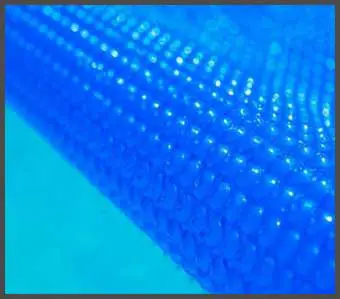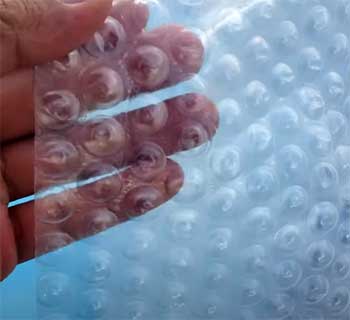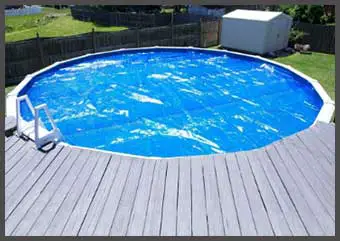When it comes to solar pool covers, Sun2Solar is one of the most well-known and trusted brands amongst pool owners. They offer a wide range of pool covers to meet different needs and budgets.
Two of their popular series are the 1200 and 1600 line of solar covers. But what exactly sets them apart?
In this comprehensive guide, we’ll explore the key differences, pros and cons, and frequently asked questions about Sun2Solar’s 1200 versus 1600 series pool covers.
Whether you’re looking to reduce pool heating costs, prolong the swimming season, or simply keep debris out of the water, understanding these key distinctions will help you determine the right Sun2Solar series for your needs and budget.
A Brief Comparison Table
| Feature | 1200 Series Pool Covers | 1600 Series Pool Covers |
| Thickness | 12 mil | 16 mil |
| Materials | Standard bubble wrap film | Premium ThermaGauge multi-layer film |
| Heat Retention | Maintains 5-10°F warmer water | Maintains 15-20°F warmer water |
| Customization | Available in pre-cut standard sizes | Fully customizable to fit any pool dimensions |
| Price | $150 – $350 | $550 – $850+ |
| Warranty | 1 year limited | 5 year limited |
| Ease of Use | Very lightweight and easy to install. Faster degradation of materials over time. | Heavier material requires careful installation but maintains performance longer. |
Overview of the 1200 vs 1600 Series
- The 1200 Series is Sun2Solar’s economy line of solar blankets. These pool covers feature 12-mil thickness and provide basic heating and cooling retention for an affordable price point. They come in various pre-cut sizes to fit most common pool types.
- The 1600 Series is their premium line of solar blankets. With robust 16-mil thickness, these covers offer advanced heat retention and durability. They’re built to last across many pool seasons. The 1600 series is also available in a wide range of custom sizes for a tailored pool coverage.
Key Differences Between Sun2Solar 1200 And 1600 Series Pool Covers
Now let’s explore some of the detailed features and performance factors.
- Thickness
One of the biggest differences comes down to the thickness, or mil measurement.

1200 Series blankets are 12-mil thick. This means they are made of 12 thousandths of an inch thick material.
At just about the thickness of a dime, these solar blankets provide basic heating efficiency.
1600 Series blankets are rated at 16-mil thickness. Built sturdier at 16 thousandths of an inch, they offer a thickness boost of over 30%.
This translates to better heat retention, lifespan, and puncture resistance.
So if you seek maximum solar heating capabilities and long-term durability to stand up to pool chemicals and weather, the 16-mil 1600 series has a clear advantage. But the 12-mil 1200 series solar covers still capture and retain heat at an affordable cost point if you’re working with a tighter budget.
- Materials
The type of materials used also impacts performance.
1200 Solar Blankets are constructed using standard bubble materials. This lightweight polymer film traps heat effectively while allowing sunlight to pass through. However, these materials tend to degrade faster than premium options when exposed to strong pool chemicals and UV rays.

1600 Solar Blankets use advanced ThermaGaugeTM materials.
This coextruded film combines thick, ultra-durable outer layers with ultra-efficient inner layers to boost heat retention.
The dense matrix design minimizes heat loss.
These premium materials stand up better to weathering, chemicals, and wear-and-tear over continual use.
So if your main goal is amplifying and retaining heat, the 1600 series solar blankets leverage thicker, more advanced materials to truly optimize solar heating capabilities. But standard 1200 bubble materials still capture and retain heat reasonably well for budget-friendly solar heating assist.
- Heat Retention
Let’s explore the solar heating performance you can expect.
Independent tests show 1200 series solar blankets provide basic heat retention, maintaining temperatures 5-10°F warmer than uncovered pools. This allows you to extend the swimming season a bit on either end of summer. It also reduces pool heating costs by 8-15% over not using any blanket.
1600 series solar blankets, constructed of thicker, premium materials, take heat retention to the next level. Testing shows they keep pools 15-20° warmer compared to uncovered pools.
This superior thermal blanket effect allows you to maximize usage well into fall and get a head start in early spring. 1600 series covers also cut pool heating electricity costs by 15-30%, adding up to major savings over time.
So while both series capture free solar heat, the 1600 line clearly excels for those seeking to minimize pool heating bills and maximize time enjoying the water.
- Customization
Another distinction comes down to sizing and customization.
1200 Series solar blankets are available in a range of pre-cut sizes to fit typical oval, rectangle, and kidney bean shaped pools. Choose from small, medium, large, and X-large sizes to get reasonably close blanket coverage for common pool dimensions.
1600 Series blankets open up much more customization flexibility. Each one is made-to-order based on your exact pool dimensions. Input the length, width, shape and more for a tailored solar cover that hugs all the contours of your pool. This prevents excess material overhang and enables maximum possible heat retention.
If you have an unusual shaped or customized pool, this made-to-order approach ensures you get a perfect solar blanket fit with the 1600 line. But the 1200 series pre-sizes still provide decent coverage for most regular shaped pools on a budget.
- Cost Comparison

When weighing the two Sun2Solar series, price and budget play an important role too.
1200 Series solar blankets start around $150 for smaller sizes up to $350 for XXL blankets. Given the affordable price yet decent pool heating support, these covers deliver good overall value. They make solar heating reasonably accessible for the masses.
1600 Series solar blankets range from $550 up to $850+ for custom sizes. Built thicker with premium materials and customized sizing, these blankets carry a higher price tag.
But their unmatched heat retention pays off the investment over time in energy savings. Their customized fit and robust durability also lend added long-term value.
Ultimately, 1600 series covers offer a superior ownership experience yet require more upfront investment. 1200 series covers provide a budget-friendly entry point into solar heating benefits.
Compare the value of upfront costs to long terms savings and usage to determine the right pool cover series for your needs and wallet.
- Ease of Use
Operation and maintenance requirements also differ somewhat.

1200 Series solar blankets are super light and easy to install.
Their pre-cut sizing simply unfolds to quickly blanket most regular pool shapes. These covers are also easy to remove and store as needed between swims.
Just roll up and stash away.
However, their thinner material can be prone to more wear and tear over time, shortening useful life.
1600 Series blankets demand a bit more initialinstallation attention given custom sizing. Take care to perfectly align all edges for maximum coverage with minimal overlaps.
This customized wrapping enables best heat harnessing but makes storage a bit bulkier between swims than standard sizes. On the plus side, thicker premium materials better withstand continual use, chemicals, and sun exposure over multiple years of reliable service.
So ease of use and lifetime convenience differs. Custom 1600 series covers demand more accuracy upfront but deliver lasting high performance.
Standard 1200 covers unfold and stow away easily, though require replacement a bit sooner as materials degrade. Determine upfront effort versus long-term usage when comparing the two cover series.
- Appearance
Visual appearance varies slightly as well.
1200 Series blankets employ a standard blue-green bubble pattern material. Visually they look like most any other solar pool cover. While colors and graphics options are very limited, their appearance gets the basic job done.
1600 Series blankets also utilize primary bubble wrap material but materials seem clearer and higher quality overall. A wider range of custom graphic prints and colors are available to match pool surroundings or highlight aesthetics. This allows personalized visuals instead of an ugly blue tarp look.
So if design and looks matter, the 1600 line offers more appearance customization to harmonize with backyard aesthetics rather than clashing. But 1200 covers still maintain a reasonably low-profile look and get hidden underwater anyway.
- Sun2Solar Warranties
Both pool cover series come standard with manufacturer’s warranties. But again, terms differ by line.
1200 Series blankets receive a** basic 1-year limited warranty**. This protects against early material defects and workmanship issues. But only for the initial 12 month period.
1600 Series blankets upgrade you to a 5-year limited warranty, amplifying early protection by 400%. Plus these thicker premium grade materials already resist issues longer by nature anyway.
So while both series carry assurance from manufacturing flaws, only 1600 blankets deliver longer lasting peace of mind.
Key Differences Summary
To recap the key distinctions:
- Thickness: 1600 blankets are 30% thicker at 16 mil versus 12 mil
- Materials: 1600 uses premium multi-layer ThermaGaugeTM film. 1200 uses standard bubble wrap.
- Heat Retention: 1600 raises pool temps 15-20°F. 1200 raises temps 5-10°F .
- Customization: 1600 are made-to-order custom sizes. 1200 come in pre-cut standard sizes.
- Price: 1600 runs $550-$850+. 1200 costs $150-$350.
- Warranties: 1600 has 5 years coverage. 1200 covers 1 year.
Now that you understand the major differences between Sun2Solar’s 1200 and 1600 series pool covers, let’s dive into some frequently asked questions.
Frequently Asked Questions (FAQ)
The mil measurement refers to the thickness of the solar blanket material. 12-mil covers are made from 12 thousandths (0.012) of an inch thick polymer bubble film. This thickness offers basic solar heat retention at an affordable price point.
16-mil covers use thicker 16 thousandths (0.016) of an inch bubble material. This added thickness enables even greater heat capture and durability. 16 mil solar pool covers last longer and maintain warmer temperatures more effectively than 12 mil blankets.
Most solar heating experts recommend 16-mil as the ideal thickness for heat retention. The thicker material prevents heat loss into the air, retaining more free warmth from sunlight. This enables your pool water to remain 15-20°F warmer than uncovered pools.
16-mil covers also prove more durable and puncture resistant as their stiff material withstands weathering and use over multiple seasons of service. Their 5-year limited warranties provide lengthier coverage too.
While 16-mil is best for maximizing solar heating, 12-mil covers still provide decent heat retention at a more budget-friendly cost if needed.
The main differences come down to thickness, materials, heat retention ability, customization, warranties and cost.
Higher end 16-mil custom covers like Sun2Solar’s 1600 Series use thicker premium materials to retain much more free solar heat, keeping pools 15-20° warmer. Their made-to-order sizing guarantees a perfect fit. But their $550-$850 price tag is an investment.
Standard 12-mil solar covers like Sun2Solar’s 1200 Series still maintain 5-10° warmer water for extending the season at an affordable $150-$350 range. Their one-size-fits most approach works for regular shaped pools.
So consider heat retention needs, customization, and budget when weighing solar pool cover options like Sun2Solar’s lines.
For safe usage and maximum heat retention, your solar cover should provide complete coverage across the entire water surface with no gaps.
Custom fit covers like SunSolar’s 1600 series allow perfect made-to-order sizing to precisely blanket your pool size and shape. This tailored approach prevents messy overhang material around the edges for optimum heating efficiency.
Standard sized covers such as Sun2Solar’s 1200 line may fit closely but not customized. Look for around 12-inch overhang past pool edges to prevent pulling too tight. If overhang excessively drags ground, anchor perimeter or fold overhang under coping tiles for safety and tidier appearance.
Closing Remarks
In comparing Sun2Solar’s 1200 and 1600 series pool covers, the 1600 line proves superior for maximum solar heating performance and durability, albeit at a higher price point.
The 1600 series’ 16-mil thickness, premium thermal plastic construction, and fully customizable sizing enable unrivaled heat retention — keeping pools 15-20°F warmer than uncovered. This translates to lower energy costs, longer swimming seasons, and getting your money’s worth from these investments long-term.
The 1200 series still harnesses the sun’s free heat at a more affordable budget-friendly price point. Despite capturing less warmth with 12-mil thinner materials, these solar blankets can satisfy cost-conscious shoppers seeking basic extensions of their pool season.
So weighing your long-term solar heating goals against budget constraints will determine the right Sun2Solar series for your pool. The 1600 line offers unmatched performance for those who can afford the higher sticker price.
But the 1200 line still brings tangible solar benefits to the masses at an attractive value.

